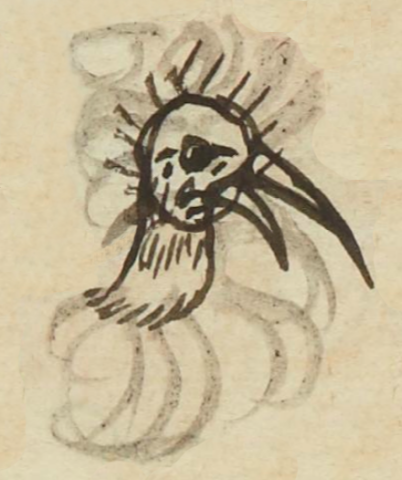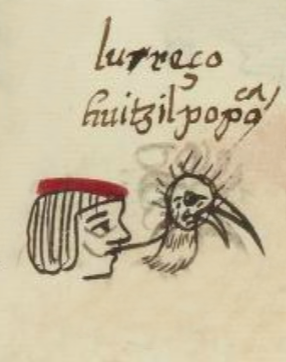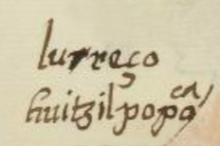Huitzilpopoca (MH507r)
This black-line drawing of the compound glyph for the personal name Huitzilpopoca shows the had of a hummingbird (huitzilin) which is smoking (popoca, the verb, to smoke]. the bird's head is shown in profile, facing toward the viewer's right. Its visible eye seems to be open, as is its beak. Appropriately for this particular bird, it has a long beak. It has short hairs coming off the top and back of its head, and it has some texturing on its face. The smoke is drawn in a gray, and it curls from all sides of the bird's head and even from its beak.
Stephanie Wood
That a hummingbird could be thought to smoke may derive from Book 11 of the Florentine Codex, which describes hummingbird feathers as being like a flame and burning, as noted by Allison Caplan (2020, 390). See comparisons for hummingbirds and curls of smoke, below. There was a known figure in early Tollan named Huitzilpopoca. He was a "speaker," according to a 1558 huehuetlahtolli record translated by Willard Gingerich. [See his free, online publication, "TLAMACHILIZTLAHTOLÇAÇANILLI: A Performance Translation of the Náhuatl 'Wisdom-Discourse Fables' from the Manuscript of 1558" (2022). Department of English Faculty Scholarship and Creative Works. 119.]
Stephanie Wood
lurreço
huitzilpopoca
Lorenzo Huitzilpopoca
Stephanie Wood
1560
Jeff Haskett-Wood
birds, hummingbirds, colibríes, smoke, smoking, humo, humear, ave, aves, pájaro, pájaros, pluma, plumas, animals, animales

huitzil(in), hummingbird, https://nahuatl.wired-humanities.org/content/huitzilin
popoca, to smoke, https://nahuatl.wired-humanities.org/content/popoca
El Colibrí Humeante(?)
Stephanie Wood
Matrícula de Huexotzinco, folio 507r, World Digital Library, https://www.loc.gov/resource/gdcwdl.wdl_15282/?sp=93&st=image
This manuscript is hosted by the Library of Congress and the World Digital Library; used here with the Creative Commons, “Attribution-NonCommercial-ShareAlike 3.0 License” (CC-BY-NC-SAq 3.0).









